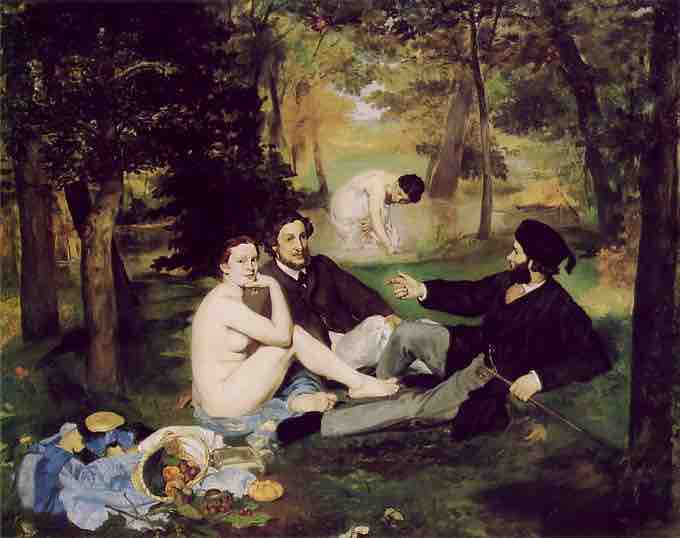Édouard Manet (1832–1883) was a French painter. One of the first nineteenth-century artists to approach modern and postmodern-life subjects, he was a pivotal figure in the transition from Realism to Impressionism. His early masterworks, The Luncheon on the Grass (Le déjeuner sur l'herbe) and Olympia, engendered great controversy and served as rallying points for the young painters who would create Impressionism. Today, these are considered watershed paintings that mark the genesis of modern art.
Olympia, Edouard Manet, 1863
Manet's Olympia was a controversial painting at the time due to the confrontational gaze of the woman depicted and also to the fact that numerous details in the painting signify that she is a prostitute.
Manet opened a studio in 1856. His style in this period was characterized by loose brush strokes, simplification of details, and the suppression of transitional tones. Adopting the current style of realism initiated by Gustave Courbet, he painted The Absinthe Drinker (1858–59) and other contemporary subjects such as beggars, singers, Gypsies, people in cafés, and bullfights. Music in the Tuileries is an early example of Manet's painterly style. Inspired by Hals and Velázquez, it is a harbinger of his lifelong interest in the subject of leisure .

Music in the Tuileries, 1862
One of Manet's earliest works that demonstrates his interests in loose bush strokes and the leisurely social activities of 19th-century Parisians.
The Paris Salon rejected The Luncheon on the Grass for exhibition in 1863. Manet exhibited it at the Salon des Refusés (Salon of the Rejected) later in the year. The painting's juxtaposition of fully dressed men and a nude woman was controversial, as was its abbreviated, sketch-like handling, an innovation that distinguished Manet from Courbet. At the same time, this composition reveals Manet's study of the old Renaissance masters. One work cited by scholars as an important precedent for Le déjeuner sur l'herbe is Giorgione's The Tempest.

Édouard Manet, The Luncheon on the Grass (Le déjeuner sur l'herbe), 1863
The painting depicts the juxtaposition of a female nude and a scantily dressed female bather on a picnic with two fully dressed men in a rural setting. Rejected by the Salon jury of 1863, Manet seized the opportunity to exhibit this and two other paintings, in the 1863 Salon des Refusés, where the painting sparked public notoriety and controversy.
As he had in Luncheon on the Grass, Manet again paraphrased a respected work by a Renaissance artist in his painting Olympia (1863), a nude portrayed in pose that was based on Titian's Venus of Urbino (1538). Manet created Olympia in response to a challenge to give the Salon a nude painting to display. His subsequently frank depiction of a self-assured prostitute was accepted by the Paris Salon in 1865, where it created a scandal. The painting was controversial partly because the nude is wearing some small items of clothing such as an orchid in her hair, a bracelet, a ribbon around her neck, and mule slippers, all of which accentuated her nakedness, sexuality, and comfortable courtesan lifestyle. The orchid, upswept hair, black cat, and bouquet of flowers were all recognized symbols of sexuality at the time. This modern Venus' body is thin, counter to prevailing standards, and this lack of physical idealism rankled viewers. Olympia's body as well as her gaze is unabashedly confrontational. She defiantly looks out as her servant offers flowers from one of her male suitors. Although her hand rests on her leg, hiding her pubic area, the reference to traditional female virtue is ironic: female modesty is notoriously absent in this work. As with Luncheon on the Grass, the painting raised the issue of prostitution within contemporary France and the roles of women within society.
The roughly painted style and photographic lighting in these two controversial works was seen by contemporaries as modern: specifically, as a challenge to the Renaissance works Manet copied or used as source material. His work is considered "early modern," partially because of the black outlining of figures, which draws attention to the surface of the picture plane and the material quality of paint.